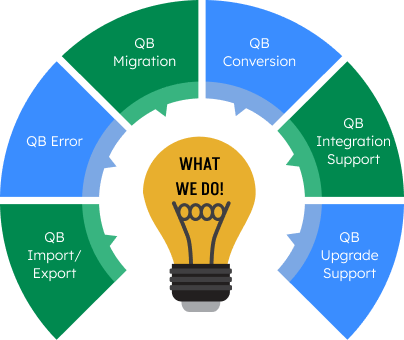A Credit Card gives you an option to borrow funds for purchases or for paying bills. The Process of paying a credit card invoice in QuickBooks Desktop generally depends on whether you’re reconciling your credit card account or paying without reconciling your account. You can set up your credit card account in QuickBooks Desktop to help you keep track of the charges and payments you made. In this post, you will learn how to Pay Credit Cards in QuickBooks with much ease. So let’s move your cursor till the end.
- Positive Balance: There are pending charges on your credit card.
- Negative Balance: The amount you paid is more than your due balance.
- Zero Balance: You did not make any charges or you already paid your balance due.
- Credit Card Sub accounts: You can enter the charges and payments in the sub-account and it will display on the account register. The total amount of these charges and payments should be equal to the total balance for the parent account. You only need to reconcile the parent account.
Get Expert Advice to Fix All Accounting & Bookkeeping Problems

Table of Contents
The process to set up, use, and pay credit card accounts in QuickBooks
- Set up credit card accounts
You are required to set up credit card accounts first in order to pay with much ease. Here’s how:
- From the Company File menu, you have to select the Chart of Accounts.
- Next, click on Account or the Plus + icon and then tap on New.
- Choose Credit Card and press the Continue button.
- Afterward, enter the credit card name on the Add New Account window.
Note: If you are setting up a sub-account, select the Subaccount of the checkbox then choose the parent account from the drop-down menu.
- Tap on entering Opening Balance and later enter the balance or date of your account.
- At last, hit Save & Close.
- Enter Credit Card Charges
To put the amount you owe in the credit card account, you need to enter the credit card charges.
- To start off, select Enter Credit Card Charges from the Banking menu.
- From the Credit Card drop-down menu, you must choose the Credit Card account.
- Purchase/Charge is the default. If you want to record a credit card or refund you received through the credit card, now tap on the Refund/Credit instead.
- Under the Purchased dropdown menu, you need to select the vendor.
- After this, choose the correct date.
- Then, enter a memo explaining the charge or refund (optional).
- Once you are done with this, press the Expenses or Items tab and type the Expenses/Items you want to track.
- The final step is to tap on Save & Close.
- Pay Credit Card Charges
It’s necessary to pay credit charges to reduce the amount you owe.
- Pay Credit Card before reconciliation
Credit Card Reconciliation is the process to ensure that the transactions made with credit cards match the transactions showing up in your general ledger. Reconciling your credit card account before you pay your credit card invoice is a good practice because it allows you to catch potential errors made by your vendor or your credit card company easily. Reconciling your credit card transactions also helps reduce the possibility of fraud in your company.
Like most account reconciliation processes, it’s how to verify that the transactions on both sides are complete, correct, and valid. Reconciliation is an essential part of the closing process where the integrity of your records is ensured.
The process of paying credit card invoices during the reconciliation of a credit card account can be accomplished in two simple steps:
- Reconcile your credit card account.
- Make a payment or enter a bill to pay later.
Reconcile your Credit Card Account
- All you need to reconcile your credit card account first of all if you’re not familiar with the process, how to reconcile a credit card balance in QuickBooks Desktop.
- Once you have successfully cleared your transactions, press the Reconcile Now button on the lower left side of the reconciliation screen.
- After clicking Reconcile Now, a small pop-up screen will appear asking how you want to make your payment.
- You can press the Write a check for payment now button or enter a bill for payment later.
- Now, choose your desired payment option and hit the OK tab. This is where the payment process actually starts.
A. Write a Check for Payment Now
The Write a Check for Payment Now button leads you to the Write Check screen. From the Write Check screen, make sure to enter the required information including as follows:
- Bank Account: Select the bank account where you want to pay the amount.
- Print Later: Check this box if you want to create the check now but wish to print it later.
- Pay to the Order of: Enter the name of the vendor. This will be generated automatically by QuickBooks Desktop.
- No.: If you wish to print the check now, ensure that you enter the correct number from the check you‘ll place in the printer.
- Date: Enter the date when you’re issuing the check.
- Amount: Write down your desired amount. You can enter a portion of the total amount due.
- Address: This field is generated automatically based on the payee information you entered in QuickBooks Desktop.
- Memo (Optional): Enter additional information like the purpose of the payment.
- Expenses or Items tab: QuickBooks will record this payment in your credit card liability account automatically as shown in the Expenses tab.
B. Enter a Bill to pay Later
Now, let’s go to the other option which is to enter a bill for payment later. When you hit the Enter a Bill for Payment Later tab, you should see the Enter a Bill screen. From here, you need to populate several fields, including the following:
- Vendor: Enter the vendor for whom you’re paying the bill.
- Address: This field is automatically populated based on the information you entered during vendor setup.
- Date: Enter the date of the credit card statement.
- Ref. No (optional): Assign a unique number to your bill.
- Amount Due: Enter the total amount of the credit card bill that you wish to pay this month.
- Bill Due: Enter the due date of the bill.
- Terms (Optional): This is generally not applicable to a credit card bill.
- Memo (Optional): Enter additional information, such as “Bill for October Credit Card Payment”.
- Expenses and Items Tab: As with a check, QuickBooks will record the bill as a reduction in your credit liability.
- Review your entry and click Save & Close.
How to Pay your Credit Card Invoice when you’re Not Reconciling your Account
If you’re not reconciling your account, follow the steps below:
- Write a check.
- Print the Check (Optional).
Write a Check
- From the Write Checks screen, provide the required information, such as the bank account, pay to the order of (vendor), and amount.
- Click on Save & Close and your credit card invoice is paid.
- Be sure to choose your credit card account on the Expenses tab.
Print the Check
You can choose to print the check now or print it later.
2. Print the Check
You can choose to print the check now or print it later. Make sure to enter the number of the first check in the starting check number:
- Write down credit card annual and finance charges
- In the beginning, select Chart of Accounts from the Company File menu.
- Now, choose the credit card account.
- From the Payee dropdown, hover over the credit card company.
- Next, enter the amount in the Charge column.
- After this, select the expense account you wish to use for tracking annual, finance, and other bank service charges under the Account dropdown menu.
- You need to choose the Tax Code.
- In the end, press Record.
Steps to pay bills with a credit card
Here’s how to pay a bill with a credit card:
- The first step is to Select + New.
- Under Suppliers click on Pay Bills.
- In the Payment account, choose your credit card account.
- Now, enter the Payment date.
- Thereafter, select the bill you wish to pay.
- Tap on Save, Save, and Print or Save and Close.
Record your Payments to credit cards in QuickBooks Online
QuickBooks Online allows you to record credit card payments in multiple ways so that you can keep track of your expenses and maintain accurate financial reports. Let’s see how:
Pay down a Credit Card
This is the most convenient or easiest way to record your credit card payments in QuickBooks.
- To proceed, Select + New.
- Under Money Out (if you’re in Business view), or Other (if you’re in Accountant view), choose to Pay down a credit card.
- Now, click on the Credit Card you made the payment to.
- Enter the payment amount.
- Thereafter, write down the date of the payment.
- Opt for the bank account you paid the credit card with.
- Select I made a payment with a cheque if you made a payment with a cheque. In the Cheque no. field, enter the cheque number or if you paid electronically, type the EFT number.
- If you want to add notes or file attachments, click Memo and attachments and follow the instructions on the screen.
- Hit Save and Close.
Some Additional Methods
Do you want to use some other methods to record credit card payments?
If Yes then here’s the list of them:
Write a cheque: If you made a credit card payment using a cheque, you can record it in QuickBooks with the help of creating a cheque.
- To start away, Select + New.
- Click Cheque under Suppliers.
- In the Payee field, choose the Suppliers name for the credit card payment.
- Now, you have to select the bank account or credit card from which the payment will be made in the Bank Account field.
- Afterward, enter a mailing address and choose a Payment date.
- In the Cheque no. field, enter the cheque number or if paid electronically, type the EFT.
- Then, make a selection from the Category drop-down menu.
- You just need to write down a description and an amount.
- Under Memo, enter notes.
- Finally, click on the Save and Close tab.
Create a Bank Transfer: You can keep a record of a credit card payment through the bank transfer.
Get Expert Advice to Fix All Accounting & Bookkeeping Problems




